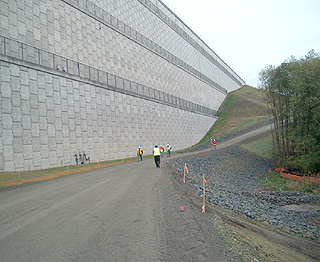|
Subscribe / Renew |
|
|
Contact Us |
|
| ► Subscribe to our Free Weekly Newsletter | |
| home | Welcome, sign in or click here to subscribe. | login |
Construction
| |
 |
November 20, 2008
Giant walls hold back a lot of dirt
Hart Crowser

Kemp
|
When the Port of Seattle built the third runway, they used more than 16 million cubic yards of fill material to make an embankment more than a mile long. That much dirt could fill the Empire State Building 12 times.
It’s also roughly the same volume of the Boeing final assembly building in Everett, the largest enclosed building in the world. It’s the weight of 270 fully loaded USS Abraham Lincolns (the largest warship ever built), and would cover the entire area of Seattle to a depth of 2 inches.
Along with the soil fill, the development needed three “mechanically stabilized earth” walls, the tallest of which is about 130 feet.
That’s the tallest wall in the Western Hemisphere, and the second tallest in an earthquake zone. The walls were needed to keep the embankment from extending over wetlands that form part of the Miller Creek Watershed. Protecting the watershed was a major goal for both the port and the local communities.
Like a layer cake
The first question that might come to mind is, Why would anybody consider building such a tall wall in an earthquake zone?
The answer is, it can’t fall down, even in an earthquake. It’s not truly a wall, although you would probably argue that fact after seeing the panels on the outside of the structure. It looks like the panels are holding back a massive amount of earth. But an MSE wall is actually a reinforced block of earth that is about as wide as it is tall.
Think of making a layer cake, except you start with a row of concrete panels lining the outer edge. Attach reinforced steel straps to the concrete panel and lay the straps out to form the first layer.
Next comes an 8- to 24-inch layer of soil. Heavy construction equipment is used to compact the soil. Then add another layer of steel straps, another layer of soil, and so on, until you reach the height of a mid-sized skyscraper.
The highest MSE walls until now have been more on the order of 90 feet tall, and only a few taller than that have been built. The third runway project team evaluated dozens of different kinds of retaining walls, and combinations of slope and wall geometries.
The MSE wall came out ahead as having the least impact to wetlands, being relatively less expensive than other alternatives, and having stellar seismic performance.
Ultra-clean soil
Engineers and consultants at the University of Washington used complex computer models to evaluate how the walls would perform during an earthquake. A board of the top experts on embankments (including seismic experts from the University of California, Davis and the Virginia Polytechnic Institute) peer-reviewed the results.
As a side note, the walls aren’t absolutely straight up and down. There are slight terraces, like the tiers of a wedding cake, but narrower.
You might think those terraces help reduce stress, and you would be correct, but the primary reason for the terraces is psychological. Without those terraces, when you stand at the base and look up, the wall would appear to be leaning over you.
The port had extremely stringent quality assurance to make sure the soil used for the embankment was uncontaminated. This kept groundwater that leached from the embankment into the wetlands and creek from impacting fish and other aquatic life.
Finding 16 million cubic yards of ultra-clean soil was a complex process that involved a number of consultants and contractors for more than two years, but it illustrates the port’s commitment to minimizing potential adverse impacts of the project.
Susan Kemp, Hart Crowser’s marketing manager, has been with the firm since 2000. Hart Crowser’s services include geotechnical and environmental engineering, natural resources and hydrogeology.
Other Stories:



